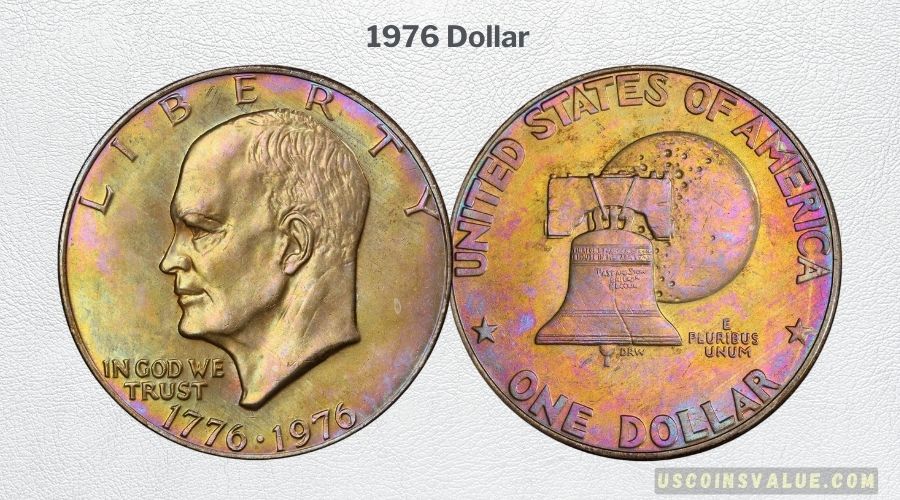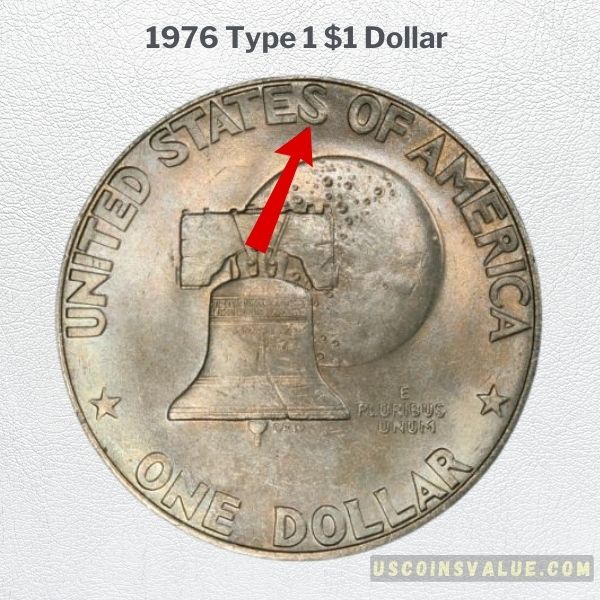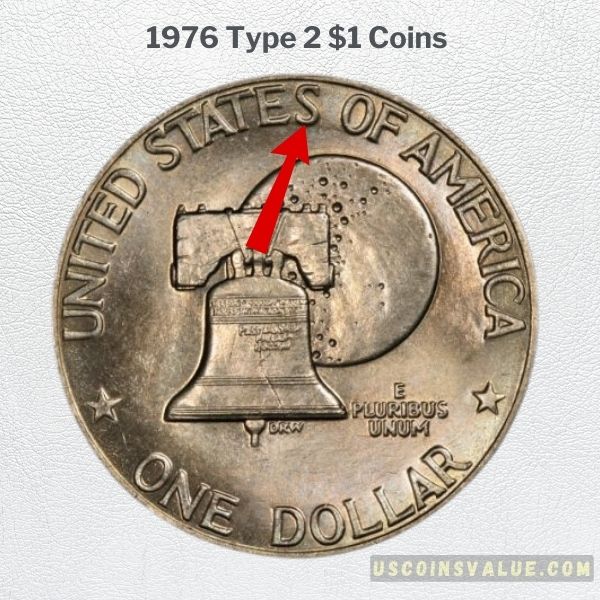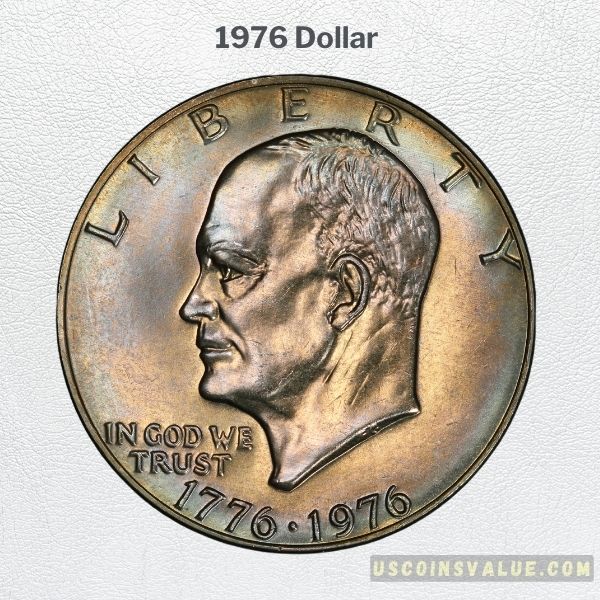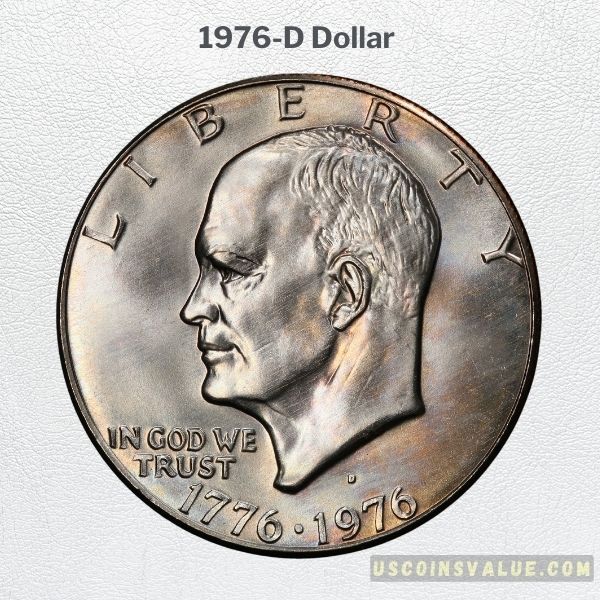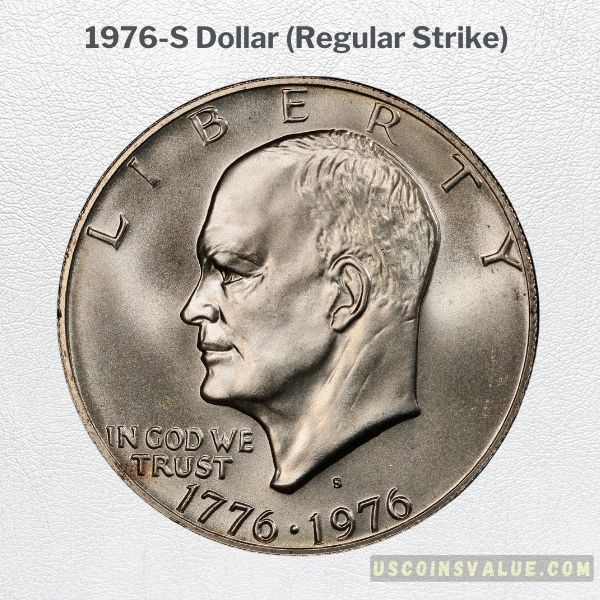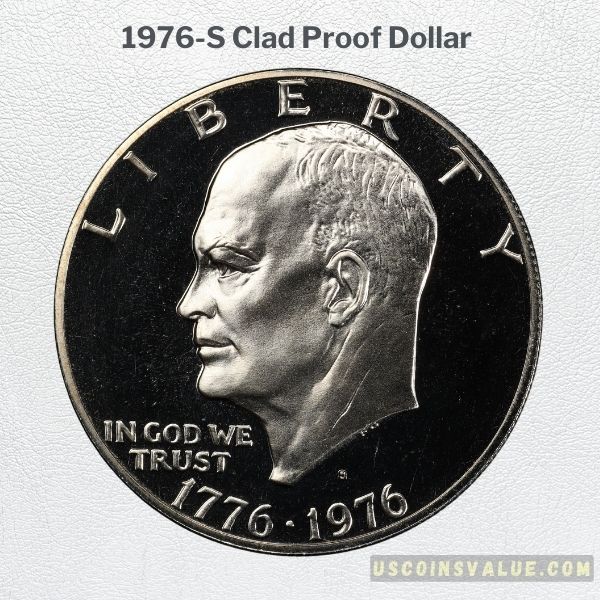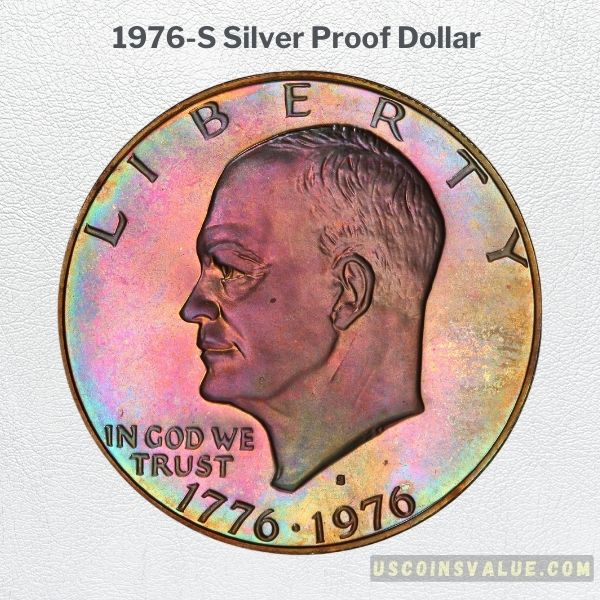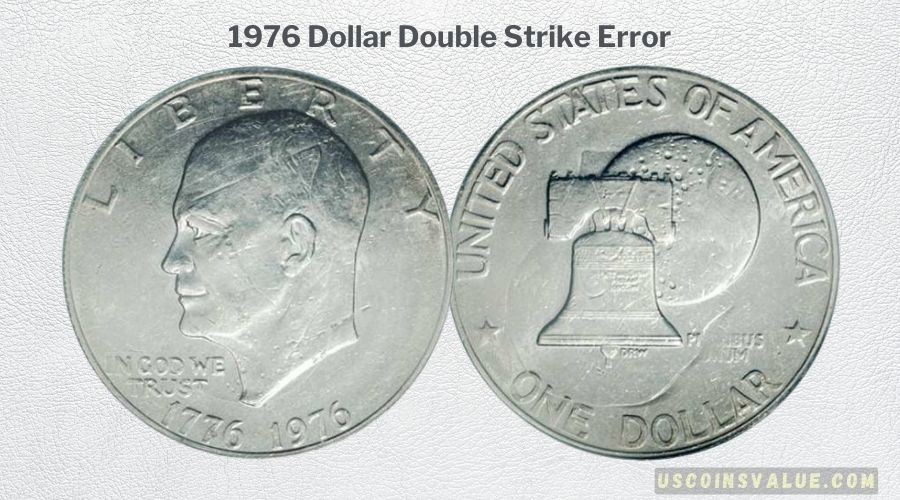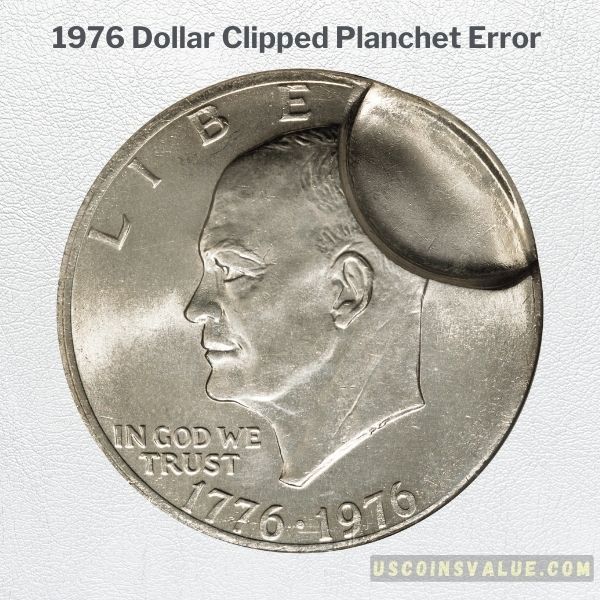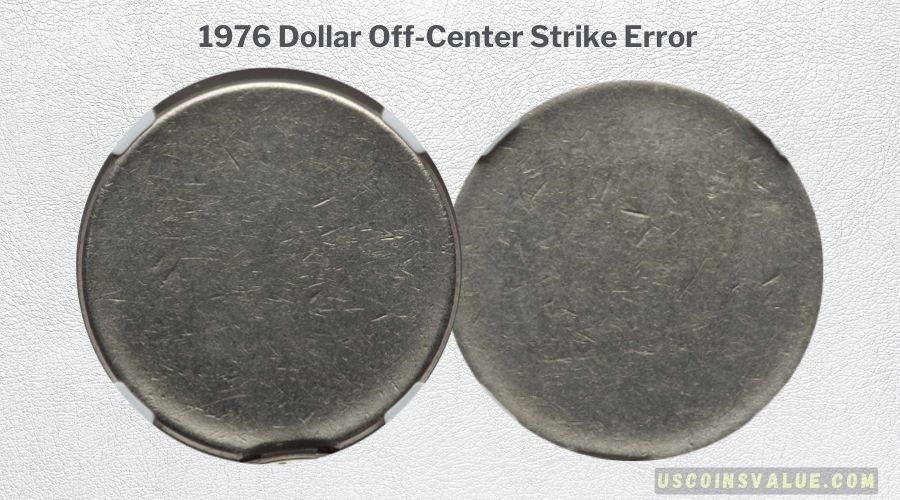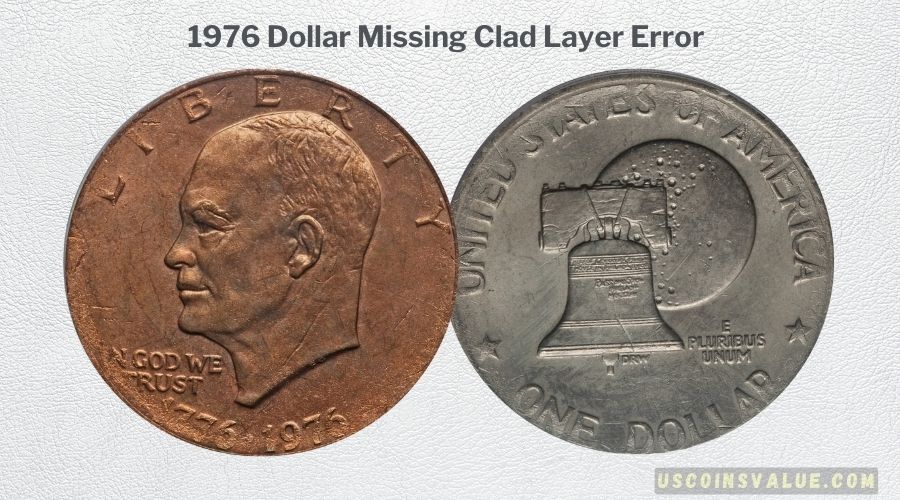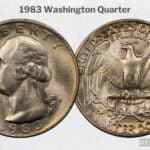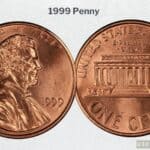Is the 1976 Eisenhower dollar worthy of being added to your coin collection? The $20,800 eBay sale this 2023 confirms the answer as yes.
Since the 1976 $1 coin comes in eight variants, it’s crucial to know the most valuable, and these factors determine value:
- Type: The 1976-S Clad, 1976-S (regular strike), and 1976-D $1 coins are the most valuable.
- Grade: MS67 – MS69 and PR68 – PR70 are worth the most money.
- Rarity: Coins with errors and unique components, like the 1976-S clad made of 40% silver, have higher demand.
Keep reading for more about varieties, errors, and the 1976 Eisenhower dollar value.
What is the Background of the 1976 Dollar Coin?
The 1976 One Dollar is one of the most exciting pieces from the Eisenhower series to collect. This series had a limited release between 1971 and 1978 as the first one-dollar coin since the Peace series in 1935.
Congress approved using late President Eisenhower’s image on the obverse as a tribute. The first set lasted from 1971 to 1974, and then there was a break in 1975.
When the Mint returned to business the following year, the 1976 came with double date errors. The minting year, “1976,” appeared beside “1776,” the Independence date.
Production became stressful because of the size and components, so Congress signed off on a new design.
The 1976 $1 coin has a unique Bicentennial reverse with a copper-nickel component. Within a year of mintage in 1975, the designers noticed a striking problem, so Frank Gasparro had to modify the die.
22-year-old Dennis R. Williams designed the now famous Liberty Bell over a Moon image for the new reverse. This change led to two types of 1976 dollars — Type 1 and Type 2.
By 1980, the Susan B Anthony dollar coin replaced the Eisenhower design.
The 1976 Dollar Coin Features
| Types | Type 1 & Type 2 |
| Series | Eisenhower |
| Designers | Frank Gasparro, Dennis R. Williams, Michael Collins & James Cooper |
| Year of Make | 1976 |
| Total Mintage | 239,715,004 |
| Mint Location | Philadelphia, Denver, San Francisco |
| Composition | 75% Copper and 25% Nickel for Regular Strike | 80% Silver and 20% Copper (Outer Layer), 21% Silver and 79% Copper (Center) for Proof Coins |
| Weight | 22.7g (Regular Strike) | 24.60g (Proof) |
| Diameter | 38.5mm |
| Edge | Reeded |
Obverse & Reverse Design
On the Obverse side, there’s a bold portrait of Eisenhower’s head looking left and stopping at the neck. Other details on the field include a mint mark under the neck where necessary and double dates.
- LIBERTY
- IN GOD WE TRUST
- 1976
- Mint Mark: “S” “D”
The bicentennial Reverse features an image of the Liberty Bell in front of the Moon at the coin’s center. Other details, including Dennis R. Williams’ initials beneath the centered image, are:
- UNITED STATES OF AMERICA
- ONE DOLLAR
- E PLURIBUS UNUM
- Two Five-Point Stars
- DRW
1976 Type 1 $1 Dollar Coins
The Type 1 1976 $1 coins have thick letters and were the first set in the series before the modified die design replaced them. The curve in the second “S” in “STATES” touches the center of the “E.”
| 1976 (Ike Eisenhower) Varieties | Composition | Mint Location & Mark | Mintage |
| 1976 Type 1 (Regular Strike) |
75% Copper and 25% Nickel |
Philadelphia (no mint mark) | 4,019,000 |
| 1976-D Type 1 (Regular Strike) | Denver (D) | 21,048,710 | |
| 1976-S Silver Type 1 (Regular Strike) | 80% Silver and 20% Copper (Outer Layer), 21% Silver and 79% Copper (Center) | San Francisco (S) | 11,000,000 |
1976 Type 2 $1 Coins
Type 2 1976 $1 coins have thin letters because of the modified die by Gasparro. Unlike the first type, the lower curve of the second “S” in “STATES” doesn’t extend beyond the bottom of the “E.”
The Denver and Philadelphia regular strike and San Francisco clad 1976 $1 coins had the original copper-nickel composition.
| 1976 (Ike Eisenhower) Varieties | Composition | Mint Location & Mark | Mintage |
| 1976 Type 2 (Regular Strike) |
75% Copper and 25% Nickel |
No Mint Mark | 113,318,000 |
| 1976-D Type 2 (Regular Strike) | Denver (D) | 82,179,564 | |
| 1976-S Type 2 Clad | San Francisco (S) | 4,149,730 | |
| 1976 “No S” silver Proof | 80% Silver and 20% Copper (Outer Layer), 21% Silver and 79% Copper (Center)
|
San Francisco | No S | 1 |
| 1976-S Silver Proof | San Francisco (S) | 4,000,000 |
How to Grade My 1976 Dollar Coin
The Sheldon scale ranging from 1 – 70, is the universally approved unit for measuring a coin’s quality. One is the least and 70 is the highest. Valuable coins fit between 60 – 70 in Mint State (MS) or Pristine (PR/PF) for Proof variants.
NB: We’re not a coin grading firm, so this is only a guide and not an authoritative grading.
| MS/PF/PR | Features |
| 60 | Zero wear signs but production errors such as markings on the surface. |
| 61 | Zero wear signs with abrasive fields and average strikes. |
| 62 | Clear details with minimal markings. |
| 63 | Hairlines on the surface with little abrasions. |
| 64 | Faint imperfections like hairlines and scratches visible under a microscope. |
| 65 | Visible details with slight hairlines and marks. Clearer than MS64. |
| 66 | Faint hairlines and marks with clear details. |
| 67 | Clear details from defined strike. |
| 68 | Clear details with little imperfections visible only under a magnifying glass. |
| 69 | Invisible imperfections only visible with professional examination. |
| 70 | Uncirculated flawless coins. Good as New! |
What’s the Current Value of the 1976 Dollar Coin (Type 1 & 2)?
| MS/PR | 1976 (Type 1 & 2) | 1976-D (Type 1 & 2) | 1976-S (Regular Strike) | 1976-S (Silver Proof) |
| 60 – 62 | $8 – $10 | $8 – $10 | $16 – $18 | $14 |
| 63 – 64 | $12 – $40 | $12 – $30 | $20 – $25 | $15 – $17 |
| 65 | $28 – $550 | $25 – $65 | $28 – $30 | $17 – $18 |
| 66 | $125 – $7,250 | $85 – $850 | $38 – $44 | $18 – $20 |
| 67 | $2,600 | $2,650 – $30,000 | $48 – $110 | $19 – $22 |
| 68 – 70 | – | – | $225 – $25,00 | $20 – $1,450 |
1. 1976 $1 (Type 1 and 2) Value
The 1976 one dollar coin value differs based on the type.
Type 1 is more valuable because it had less mintage making fewer pieces available in today’s market. For example, the lowest price for a Type 2 “no mint mark” 1976 $1 coin in MS64 is $15, while it’s $28 for a Type 1 variant.
In 2023, Heritage Auctions sold MS66 grade Type 1 “no mint mark” coins for $1,380, while Stack’s Bowers sold the same grade for $1,320 in April 2023. Type 2 variants of this 1976 $1 coin went for $25 on David Lawrence RC and $64 at Heritage Auctions.
| Grade | Highest Price & Sale Date | Firm |
| MS64 (Type 2) | $8,050 (2007) | Heritage Auctions |
| MS66 (Type 1) | $7,638 (2014) | Heritage Auctions |
| MS67 (Type 2) | $6,325 (2011) | Heritage Auctions |
| MS66+ (Type 1) | $5,640 (2017) | Heritage Auctions |
| MS67 (Type 2) | $4,715 (2004) | Legend Rare Coin Auctions |
2. 1976-D $1 Value (Type 1 and 2)
Like the “no mint mark” 1976 one-dollar coin, the 1976-D Type 1 coin is also more valuable than its Type 2 coin. With over 82 million Type 2 pieces minted, there’s enough to go around for modern-day collectors.
The highest-valued 1976-D one-dollar coin is the Type 1 MS67+ grade at $30,000, while the Type 2 MS67+ is worth $7,500 at most.
In Feb. 2023, Heritage Auctions sold a Type 1 MS66 grade for $312, while Stack’s Bowers sold a similar grade for $144 two months later. For Type 2, an MS67 grade went for $2,400 in July 2023 at Heritage Auctions.
That’s one of the highest sales in recent years, but it’s still not close to the auction record of $14,375 for a Type 1 and $5,060 for a Type 2 1976-D $1 coin.
Other high sales for Type 2 variants include $4,080 by Stack’s Bowers for an MS66 grade in 2020 and $3,600 for an MS67 grade in 2021.
While they’re relatively pricey, they aren’t as expensive as some of the highest-grade Type 1 1976-D $1 coins sold.
Here’s a list for you.
| Grade | Highest Price & Sale Date | Firm |
| MS63 (Type 1) | $14,375 (2001) | Bowers & Merena |
| MS67 (Type 1) | $11,163 (2015) | Heritage Auctions |
| MS67 (Type 1) | $9,600 (2020) | Stack’s Bowers |
| MS67 (Type1) | $8,813 (2016) | Heritage Auctions |
| MS62 (Type 2) | $5,060 (2006) | American Numismatic Rarities |
3. 1976-S $1 (Regular Strike)
The 1976 silver dollar value is still high in today’s market because of its composition. A regular strike of this variant is still worth at least $16 in MS60 grade and $25,000 in MS69. Two of its highest sales, including the record price, happened in 2023.
eBay made the first record of $20,800 in Mar. 2023 for an MS69 grade. Then Heritage Auctions followed closely with $18,600 for the same grade in July, and Stack’s Bowers trailed behind with a $4,320 sale for an MS68+ grade in Mar. 2023.
New collectors can still own MS66 – MS67 pieces on a budget of $40 or less if they buy from eBay.
| Grade | Highest Price & Sale Date | Firm |
| MS69 | $20,800 (2023) | eBay |
| MS69 | $18,600 (2023) | Heritage Auctions |
| MS69 | $4,560 (2019) | Heritage Auctions |
| MS68+ | $4,320 (2023) | Stack’s Bowers |
| MS68 | $1,920 (2021) | Stack’s Bowers |
4. 1976-S Clad (Type 1 and 2) Proof $1 Coins
The 1976-S Clad one-dollar coin was one of the most valuable variants and even scored a whopping $41,400 in 2002 at auction. It had a unique 40% Silver-clad design meant to give it a different look and separate it as a collectible.
The idea lasted for only a few months before Congress scrapped it. Unfortunately, it has no current value, as the last recorded Auction site sales were in 2022.
However, private vendors traded Type 1 1976-S clad $1 coins on eBay in 2023. The sale prices were low and ranged between $10 – $30. Meanwhile, sales soared for Type 2 clad coins!
Heritage Auctions sold three PR70DCAM $1976-S Clad Type 2 coins in 2023 for $2,280 and $3,000 in Jan. and $1,860 in May of the same year.
| Grade | Highest Price & Sale Date | Firm |
| PR66 (Type 2) | $41,400 (2002) | Bowers & Merena |
| PR70 (Type 1) | $25,300 (2011) | Heritage Auctions |
| PR70 (Type 2) | $22,550 (2014) | Great Collections |
| PR70DCAM (Type 1) | $7,638 (2016) | Heritage Auctions |
| PR70 (Type 2) | $5,170 (2015) | Heritage Auctions |
5. 1976-S Silver Proof
There’s only one type of the 1976-S Silver Proof coin because there was no problem with the die from inception.
The 1976-S Silver Proof $1 coin has an auction record of $6,900 by Heritage Auctions in 2008. As of 2023, you can buy a PR60 grade for as low as $14, while PR70DAM grades sell for as high as $840 and $930.
Also, only one “no s” 1976 Type 2 Silver Proof one-dollar coin has been recorded in history. It’s graded PR68, and an eBay vendor sold it for $450 in 2022.
| Grade | Highest Price & Sale Date | Firm |
| PR70 | $6,900 (2008) | Heritage Auctions |
| PR70 | $6,325 (2008) | Heritage Auctions |
| PR70 | $5,865 (2007) | Heritage Auctions |
| PR70 | $5,175 (2007) | Heritage Auctions |
| PR70 | $4,888 (2007) | Heritage Auctions |
Common Errors You’ll Find in a 1976 $1 Coin
Besides the die error that caused a split into two types of 1976 $1 coins, there are other common errors you’ll find with this series. Some of them include:
- Double Strike Error
- Planchet Error
- Off-Center Strike Error
- Missing Clad Layer Error
1. Double Strike Error
When the die isn’t clear enough on the first strike, there’s a second strike on the planchet. This duplicates the images on the coin’s obverse or reverse.
With this error, you can still earn some dollars trading a 1976 $1 coin. A Flipover double strike error 1976 $1 Type II coin sold for $2,530 in 2004 at Heritage Auctions.
2. Clipped Planchet Error
If there’s a mistake cutting the base metal for striking a coin, you’ll get a clipped planchet error. It’s one of the most common 1976 Eisenhower dollar coin errors.
In 2008, Heritage Auctions sold a Type II 1976 $1 coin with an indented planchet error for $3,220. Another quarter-indented planchet Type II coin went for $1,997.50 in 2017, and the firm sold a clipped planchet error MS63 Type II $1 coin for $138 in 2004.
3. Off-Center Strike Error
A loose retaining collar causes the planchet to shift during production, leading to an off-center strike. The shift could range from 5% – 95%, with the wider off-center strikes carrying more value.
A 1976 $1 coin graded MS66 with a 95% off-center strike, leaving a blank surface except for a partial detail on the edge, sold for $258.50 at Heritage Auctions in 2017.
4. Missing Clad Layer Error
The 1976 “no mint mark” $1 coin has a standard component of nickel poured over a copper center. When one of these two layers isn’t present, the coin comes out in a different color. A missing clad layer error 1976 $1 coin is still worth up to a thousand dollars in resale.
Heritage Auctions sold an MS64 grade Type II “no mint mark” 1976 dollar coin with a missing obverse clad layer for $1,057.50 in 2017.
Final Thoughts
There are so many variants of the 1976 $1 coin that it’s easy to get overwhelmed as a collector. It’s best to take your time with this series and examine each piece before purchase.
Always ensure it’s graded professionally, or use the grading guide we’ve provided in this review. As a rule of thumb, know that the most valuable variants are the Proof and 1976-S regular strike $1 coins.
We believe you won’t regret adding the 1976 Eisenhower dollar to your collection!

